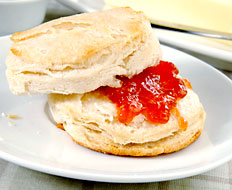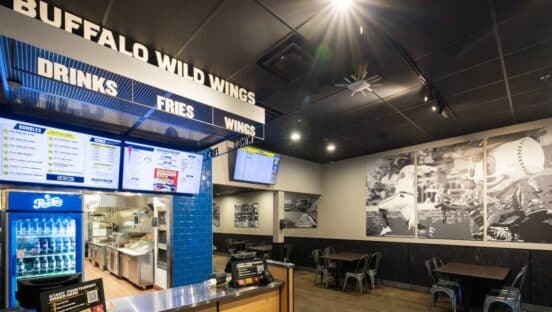Fruits and vegetables constitute half of the USDA’s new, post-Pyramid “MyPlate” dietary diagram. That means the agency recommends Americans get somewhere in the neighborhood of 50 percent of their daily calories from the stuff.
If steamed cauliflower tasted like seasoned curly fries and blanched asparagus was indistinguishable in blind taste tests from a bag of fresh-made sliders, this dietary advice might go down a bit easier with most consumers.
Fortunately, even those diners who view anything green, leafy, or cruciferous with a mix of fear, loathing, and dread often have a soft spot for apples, berries, drupe, and hesperidia (look ’em up, impress your friends!). The apple, remember, even stands as the original embodiment of temptation; the whole Edenic saga might have unfolded quite a bit differently had the Genesis farmers’ market carried only fiddlehead ferns, leeks, and Brussels sprouts.
Until relatively recently, the fast food fruit department consisted primarily of deep-fried apple pies, strawberry-flavored shakes, and blister packs of orange marmalade for your English muffin or toast. But for operators mindful that fresh fruit offerings can boost the health quotient of their menus while addressing increased consumer demand for fresher offerings, the picture is changing rapidly. These days, bite-sized apple chunks, berry-yogurt parfaits, real fruit smoothies, and salads flecked with everything from mandarin orange pieces and diced strawberries to raisins, dried cranberries, and slices of Granny Smith apples are turning up on quick-serve and fast-casual menus everywhere.
So where to go from here? Following are a few thoughts on how to tap even further into consumers’ fruit fancy and make maximum use of an often-underutilized ingredient category.
Give it a Strong Supporting Role
Fresh fruit toppings, condiments, dressings, jellies, jams, ketchup, preserves, and chutneys can enliven the flavor profile of any number of products while serving as a signifier of freshness and quality. Blackberry or peach jam on country ham on a KFC biscuit? It might seem counterintuitive, but once people experience the sweet and savory a fruit-and-cured-meat combination brings, they may be hooked. Food & Wine magazine recently featured veggie burgers with—wait for it—pomegranate ketchup among its top five recipes of the day, and the trend toward employing fruit in novel contexts is unquestionably gathering momentum.
Let it Co-Star
The dessert watchwords in the white-tablecloth world and the hip café segment nowadays are “pies, pies, and more pies.” Something about that timeless fusion of pastry and fruit is sparking a pie renaissance in places you might not expect. From farmers’ markets to street-corner carts and trendy eateries around the nation, pies are scorching hot, and nontraditional renderings of the dessert mainstay are taking their place alongside traditional varieties.
The Three Babes Bakeshop in San Francisco’s Potrero Hill neighborhood offers fruit-based, custard-based, chocolate, and savory pies. They even offer pies packaged in a nonstandard, but highly convenient, format: a simple glass jar, which naturally makes for easier storage, handling, and improved shelf life.
An even more quick-serve-friendly format is the increasingly popular “pie pop”—essentially a miniature pie on a lollipop stick—now featured at High 5 Pie on 12th Avenue in Seattle. Along with that innovative item, High 5 Pie also serves miniature pies in muffin tins, pie bites served in batches of five, and handheld turnovers. All or most would seem to be perfect fits for quick serves’ portability-craving customers.
Make it the Main Attraction
Loads of quick-serve and fast-casual establishments now make hay out of the cook-to-order proposition, which connotes freshness, quality, and customization in the minds of loyal customers. But what about freezing items to order—items ranging from personalized sorbets, popsicles, and frozen novelties to actual chunks of fresh fruit?
An Illinois-based company called PolyScience markets what it calls the Anti-Griddle—a device billed as a tool for “quickly freezing sauces and purées into solid, unique forms,” or freezing “just the outer surfaces while maintaining a creamy center.”
The implications of this kind of technology for getting more fruit on the menu are varied. Fresh-squeezed juice combinations could quickly be turned into made-to-order popsicles or pop-ups. Frozen agua frescas or real berry slushes could provide healthier, lower-calorie alternatives to milkshakes. When freezing is transformed from a multihour undertaking to a process that takes a matter of moments, the creative menu developer can come up with dozens of ways to deliver fresh-frozen fruit concoctions.
Whichever route you choose, the important thing to remember is that with the USDA, the First Lady, and other prominent agencies and individuals touting the value of getting more nourishment from fruits and vegetables, the time may well be ripe to reconsider where fruit fits on your menu.












